For a fully active starter to reach peak activity, takes 2-4 hrs. per Ed Woods Book. Your 65º ambient is low, so It might take a little longer. Shawn, a heating pad in a box set on low works very well for a proofing box. That's what I use to keep a constant temp when activating and proofing a culture. Link to Ed's book and web site.
You are using an out of date browser. It may not display this or other websites correctly.
You should upgrade or use an alternative browser.
You should upgrade or use an alternative browser.
Sourdough Starter Culture
- Thread starter Shawn W
- Start date
Matt Albright
TVWBB Member
Sorry it took me so long to reply about the potato starter...
You do not add any flour to the starter culture at all. Usally about once a week (but can go 2 weeks) I take it from the refrigerator, bring it to room temp, add the water, sugar and potato flakes. Let it sit out overnight.
Remove 1-1(1/4) C. of starter. Make something, toss it out or give it away.
Made some bread last week... Mighty fine!
You do not add any flour to the starter culture at all. Usally about once a week (but can go 2 weeks) I take it from the refrigerator, bring it to room temp, add the water, sugar and potato flakes. Let it sit out overnight.
Remove 1-1(1/4) C. of starter. Make something, toss it out or give it away.
Made some bread last week... Mighty fine!
Shawn W
TVWBB Emerald Member
1 month and the flour only starter is in really good shape, very active, smells great! I'm making my first loaf with it tomorrow (overnight rise).
The kraut juice starter is in cold storage. It really has a distinct sour going in it, time will tell if it stays unique tasting.
The rye starter has another 5 days or so to get to 1 month old. This one, actually all of them have a distinct smell.
Keeping the potato starter alive, and I hope to use it next week.
I got my Friends Of Carl free starter in the mail, but i'm going to hold off for the time being.
My Kitchen Aid died when I made my last sourdough loaves, my FIL dropped off ~15 loaves of bread, buns and such ... I haven't in the least needed to make bread the last little while. I dried the bulk of those loaves out for stuffing, but I won't tell him that.
BTW: I found instructions on Carl's site on how to dry out and put your starter into dry storage. It's really easy, I'm going to do that with any starter I'm happy with. It seems to take at least a good couple weeks of throwing out flour to get a sturdy good tasting starter. WHy start again or keep feeding if you know you just aren't going to use it for a while?
I've ordered the book Bryan suggested as well. I'll try to get some pics up in the next couple of days of my first loaves.
The kraut juice starter is in cold storage. It really has a distinct sour going in it, time will tell if it stays unique tasting.
The rye starter has another 5 days or so to get to 1 month old. This one, actually all of them have a distinct smell.
Keeping the potato starter alive, and I hope to use it next week.
I got my Friends Of Carl free starter in the mail, but i'm going to hold off for the time being.
My Kitchen Aid died when I made my last sourdough loaves, my FIL dropped off ~15 loaves of bread, buns and such ... I haven't in the least needed to make bread the last little while. I dried the bulk of those loaves out for stuffing, but I won't tell him that.
BTW: I found instructions on Carl's site on how to dry out and put your starter into dry storage. It's really easy, I'm going to do that with any starter I'm happy with. It seems to take at least a good couple weeks of throwing out flour to get a sturdy good tasting starter. WHy start again or keep feeding if you know you just aren't going to use it for a while?
I've ordered the book Bryan suggested as well. I'll try to get some pics up in the next couple of days of my first loaves.
Shawn W
TVWBB Emerald Member
I got back to this after reading Ed Wood's Sourdough book and I've finally gotten some worthwhile fruits from my labours and all the discarded flour.
The book was ok ... doesn't talk much about baking so I have more questions than I started with but it was fine, worth the money. It comes with 100 pages of recipes. They should give you a coupon for a freebie starter when you buy the book (they sell a number of varieties including San Francisco .... prices vary... link to Sourdo.com cultures).
So not being able to tell my starters apart any more by smell or behaviour, I combined them and washed them and made some sourdough bagels. These really turned out great! Much, much better than the last attempt.
Photo Thumb Links (for Doug)
Out of the fridge after overnight, poke method instead of roll much easier:
<A HREF="http://s715.photobucket.com/albums/ww154/shawnwBBQ/2009%20Bagels/?action=view¤t=2009-01-08a011.jpg" TARGET=_blank>

</A>
Boiling in malted water:
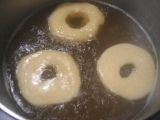
Ready to Bake:
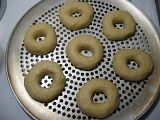
Done:
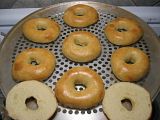
Close up:
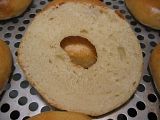
Made some ok bread with the potato starter but I need a better recipe. I'll try it some more since it has a great flavor.
Haven't activated my Oregon Trail starter yet. My home made is performing well and washing it took the sour down a number of notches, I can see why they call it sweetening the pot.
So I guess I'll wrap this thread up for now ... my experience was rye starter worked best, on my cool counter it took a few weeks to build a robust starter, I washed it to sweeten it and it's working and tasting well.
Wash process: discard all but 1C, add another C or two or three of water, stir well, discard all but 1C, build back consistency by adding flour and stirring every 6 - 12 hours in 85ºF)
Thanks all for your help!
The book was ok ... doesn't talk much about baking so I have more questions than I started with but it was fine, worth the money. It comes with 100 pages of recipes. They should give you a coupon for a freebie starter when you buy the book (they sell a number of varieties including San Francisco .... prices vary... link to Sourdo.com cultures).
So not being able to tell my starters apart any more by smell or behaviour, I combined them and washed them and made some sourdough bagels. These really turned out great! Much, much better than the last attempt.
Photo Thumb Links (for Doug)
Out of the fridge after overnight, poke method instead of roll much easier:
<A HREF="http://s715.photobucket.com/albums/ww154/shawnwBBQ/2009%20Bagels/?action=view¤t=2009-01-08a011.jpg" TARGET=_blank>

</A>
Boiling in malted water:

Ready to Bake:

Done:

Close up:

Made some ok bread with the potato starter but I need a better recipe. I'll try it some more since it has a great flavor.
Haven't activated my Oregon Trail starter yet. My home made is performing well and washing it took the sour down a number of notches, I can see why they call it sweetening the pot.
So I guess I'll wrap this thread up for now ... my experience was rye starter worked best, on my cool counter it took a few weeks to build a robust starter, I washed it to sweeten it and it's working and tasting well.
Wash process: discard all but 1C, add another C or two or three of water, stir well, discard all but 1C, build back consistency by adding flour and stirring every 6 - 12 hours in 85ºF)
Thanks all for your help!
Shawn W
TVWBB Emerald Member
Thanks B, yeah that's Ed's recipe. I did a couple things different: boiled in malt extract, hand rolled them well into a ball instead of a rope and did poke method (forming a seam on a rope I found way too tedious), friged the formed bagels overnight instead of proofing for an hour then cooking.
I'm looking forward to trying his english muffin recipe too ... love the store bought ones so I bet these will be freakin awesome!
Thanks again for the tip about his book I'm glad I bought it.
I'm looking forward to trying his english muffin recipe too ... love the store bought ones so I bet these will be freakin awesome!
Thanks again for the tip about his book I'm glad I bought it.
Shawn W
TVWBB Emerald Member
<BLOCKQUOTE class="ip-ubbcode-quote"><div class="ip-ubbcode-quote-title">quote:</div><div class="ip-ubbcode-quote-content">I'm looking forward to trying his english muffin recipe too ... </div></BLOCKQUOTE>I used my sourdough to try Ed's English Muffins, and I also made Eggs Benedict with them and some WSM smoked back bacon.
The muffins were quite good, nice flavor after 24+ hours of proofing with 2 flour dumps, though different from store bought.
They didn't have the huge air holes inside like store bought. I'm curious as to why (but not unhappy at all with these), perhaps store bought are wetter, more like a batter than a dough?
I weighed each one and formed by hand rather than rolling and cutting. Sprinkled corn meal on a cookie sheet, placed them, then brushed with melted butter and sprinkled corn meal on top.
Tried cooking a couple different ways, settled on 16 minutes at 450ºF, no flipping (Ed says 7.5 minutes, flip, 7.5 minutes).

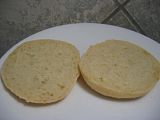
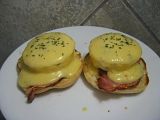
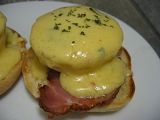
The muffins were quite good, nice flavor after 24+ hours of proofing with 2 flour dumps, though different from store bought.
They didn't have the huge air holes inside like store bought. I'm curious as to why (but not unhappy at all with these), perhaps store bought are wetter, more like a batter than a dough?
I weighed each one and formed by hand rather than rolling and cutting. Sprinkled corn meal on a cookie sheet, placed them, then brushed with melted butter and sprinkled corn meal on top.
Tried cooking a couple different ways, settled on 16 minutes at 450ºF, no flipping (Ed says 7.5 minutes, flip, 7.5 minutes).




D. L. Whitehead
TVWBB Super Fan
<BLOCKQUOTE class="ip-ubbcode-quote"><div class="ip-ubbcode-quote-title">quote:</div><div class="ip-ubbcode-quote-content">Originally posted by Shawn W:
Tried cooking a couple different ways, settled on 16 minutes at 450ºF, no flipping (Ed says 7.5 minutes, flip, 7.5 minutes). </div></BLOCKQUOTE>
Hi Sourdough Shawn,
So, did you bake them? Or, griddle them?
###
Tried cooking a couple different ways, settled on 16 minutes at 450ºF, no flipping (Ed says 7.5 minutes, flip, 7.5 minutes). </div></BLOCKQUOTE>
Hi Sourdough Shawn,
So, did you bake them? Or, griddle them?
###
Shawn W
TVWBB Emerald Member
<BLOCKQUOTE class="ip-ubbcode-quote"><div class="ip-ubbcode-quote-title">quote:</div><div class="ip-ubbcode-quote-content">Originally posted by D. L. Whitehead:
<BLOCKQUOTE class="ip-ubbcode-quote"><div class="ip-ubbcode-quote-title">quote:</div><div class="ip-ubbcode-quote-content">Originally posted by Shawn W:
Tried cooking a couple different ways, settled on 16 minutes at 450ºF, no flipping (Ed says 7.5 minutes, flip, 7.5 minutes). </div></BLOCKQUOTE>
Hi Sourdough Shawn,
So, did you bake them? Or, griddle them?
### </div></BLOCKQUOTE>Sourdough Shaw ... heh heh
I went with baking rather than griddling
<BLOCKQUOTE class="ip-ubbcode-quote"><div class="ip-ubbcode-quote-title">quote:</div><div class="ip-ubbcode-quote-content">Originally posted by Shawn W:
Tried cooking a couple different ways, settled on 16 minutes at 450ºF, no flipping (Ed says 7.5 minutes, flip, 7.5 minutes). </div></BLOCKQUOTE>
Hi Sourdough Shawn,
So, did you bake them? Or, griddle them?
### </div></BLOCKQUOTE>Sourdough Shaw ... heh heh
I went with baking rather than griddling
D. L. Whitehead
TVWBB Super Fan
<BLOCKQUOTE class="ip-ubbcode-quote"><div class="ip-ubbcode-quote-title">quote:</div><div class="ip-ubbcode-quote-content">Originally posted by Shawn W:
I went with baking rather than griddling </div></BLOCKQUOTE>
I've looked at a goodly number of English muffin recipes and, even, prepared a few of them. I don't recall ever seeing a recipe where English muffins were baked. I do recall one recipe that was initially griddled and, then, finished by baking.
Perhaps the baking yields a different texture.
Hey, they looked good, especially as the Eggs Benedict with smoked bacon!
###
I went with baking rather than griddling </div></BLOCKQUOTE>
I've looked at a goodly number of English muffin recipes and, even, prepared a few of them. I don't recall ever seeing a recipe where English muffins were baked. I do recall one recipe that was initially griddled and, then, finished by baking.
Perhaps the baking yields a different texture.
Hey, they looked good, especially as the Eggs Benedict with smoked bacon!
###
Shawn W
TVWBB Emerald Member
I should clarify a bit:
Ed's recipe says <BLOCKQUOTE class="ip-ubbcode-quote"><div class="ip-ubbcode-quote-title">quote:</div><div class="ip-ubbcode-quote-content"> Cook on a large electric griddle preheated to 400º. After 2 minutes, when the bottoms are browned, reduce heat to 325º, turn the muffins, and cook 8 minutes on the other side. Then turn again and cook another 6 minutes, or alternatively, bake in a preheated oven at 450º for 7.5 minute. Turn them over and bake an additional 7.5 minutes. </div></BLOCKQUOTE> I chose the latter since I had too much going on to stand and fiddle with temps and 2 turns per batch.
Thanks for the tip DL, I'll try griddling when I have more time. Maybe it is different like you say, an intense oven kick sort of thing.
Ed's recipe says <BLOCKQUOTE class="ip-ubbcode-quote"><div class="ip-ubbcode-quote-title">quote:</div><div class="ip-ubbcode-quote-content"> Cook on a large electric griddle preheated to 400º. After 2 minutes, when the bottoms are browned, reduce heat to 325º, turn the muffins, and cook 8 minutes on the other side. Then turn again and cook another 6 minutes, or alternatively, bake in a preheated oven at 450º for 7.5 minute. Turn them over and bake an additional 7.5 minutes. </div></BLOCKQUOTE> I chose the latter since I had too much going on to stand and fiddle with temps and 2 turns per batch.
Thanks for the tip DL, I'll try griddling when I have more time. Maybe it is different like you say, an intense oven kick sort of thing.
<BLOCKQUOTE class="ip-ubbcode-quote"><div class="ip-ubbcode-quote-title">quote:</div><div class="ip-ubbcode-quote-content">Originally posted by Shawn W:
They didn't have the huge air holes inside like store bought. I'm curious as to why (but not unhappy at all with these), perhaps store bought are wetter, more like a batter than a dough? </div></BLOCKQUOTE>
Shawn, the longer they proof, the bigger the air holes. Maybe the starter wasn't quite fully active. As in maybe another hour of proofing after forming the muffins but before cooking them to get the larger air holes in the muffins. At any rate, the muffins and the eggs benedict, looks freaking fantasic Buddy. Great job.

They didn't have the huge air holes inside like store bought. I'm curious as to why (but not unhappy at all with these), perhaps store bought are wetter, more like a batter than a dough? </div></BLOCKQUOTE>
Shawn, the longer they proof, the bigger the air holes. Maybe the starter wasn't quite fully active. As in maybe another hour of proofing after forming the muffins but before cooking them to get the larger air holes in the muffins. At any rate, the muffins and the eggs benedict, looks freaking fantasic Buddy. Great job.

